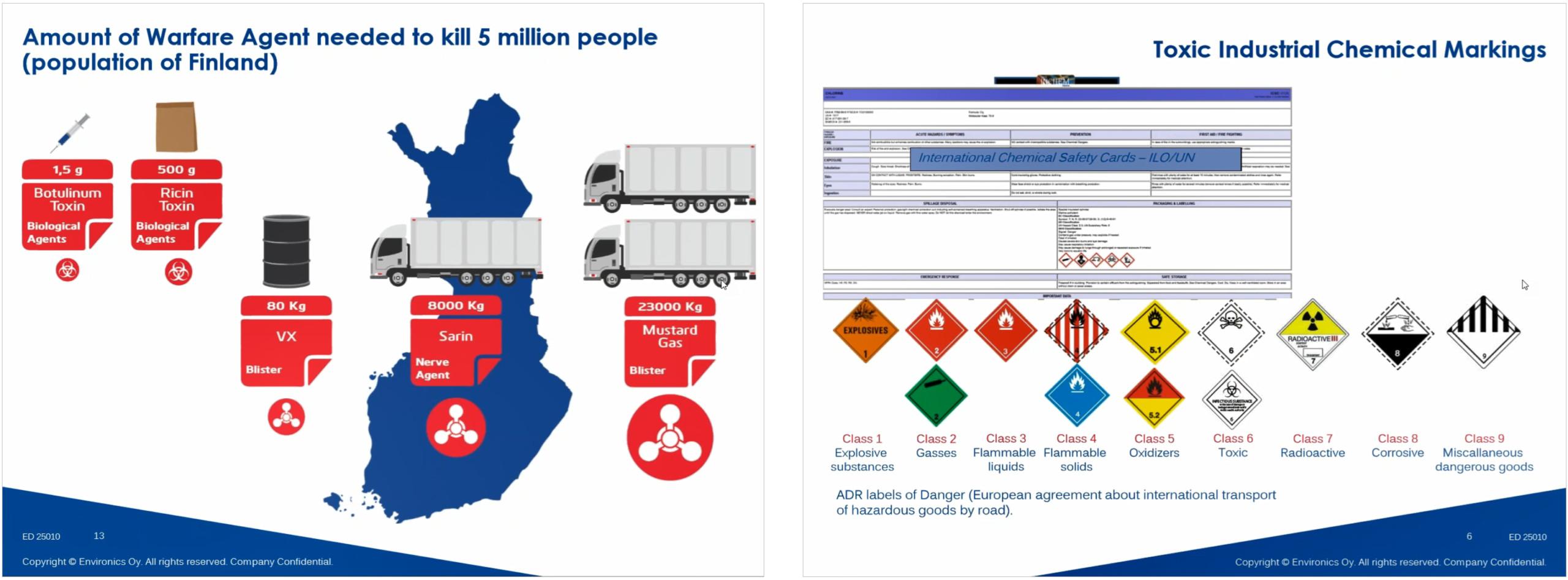What Are Chemical Agents?
In “CBRN Agents – Chemical Agents: CWA & TIC”, Training Manager Toni Leikas exposes basic knowledge regarding the charecteristics of Chemical Warfare Agents and Toxic Industrial Chemicals. This 40 min session comprises theoretical information as well as practical knowledge, such as the interpretation of International Chemical Safety Cards, or even wild curiosities such as the amount of CWAs necessary to kill 5 million individuals, the entire population of Finland.

“CBRN Agents – Chemical Agents: CWA & TIC” free webinar preview slides featuring selected information tailored by Training Manager Toni Leikas.
What Are Chemical Warfare Agents or CWAs?
Chemical Warfare Agents are toxic substances developed for military use and intended to cause death or serious injury. There are approximately 30 main traditional chemical warfare agent formulations, including all different variations of standard CWAs.
Chemical agents can affect different physiological systems by entering the human body through ingestion, skin or eye absorption, and inhalation.
These agents are categorized according to their physiological effects: nerve, blood and choking, and blistering agents.
Chocking Agents
Also known as pulmonary agents, choking agents cause damage to the lungs, irritation to the eyes and the respiratory tract, and pulmonary oedema. E.g. of a Choking Agent: Chlorine.
Blood Agents
Also known as cyanides, blood agents are transported by the blood stream to all body tissues. They distribute the oxidative processes used by the cells or hemolysis of the red blood cells. E.g. of Blood Agents: Hydrogen cyanide, Cyanogen chloride and Arsine (SA).
Blister Agents
Also known as vesicants, blister agents are noted for producing reddening and blistering of the skin, but the eyes and respiratory tract are more sensitive than the skin. Eye exposure results in reddening of the eyes and temporary or permanent blindness. Inhaled mustard damages mucous membranes and the respiratory tract. E.g. of Blister Agents: Nitrogen mustard, Sulphur mustard and Lewisite.
Nerve Agents
Nerve Agents inhibit cholinesterase (ChE) enzymes. This inhibition permits acetylcholine (ACh), which transmits many nerve impulses, to collect at its various sites of action. The body’s muscles and glands become over stimulated due to excessive amounts of ACh. At sufficient doses, this can lead to an inability of the body to sustain breathing. E.g. of Nerve Agents: Soman, Tabun, Sarin, VX, RVX and Novichok.
What are Toxic Industrial Chemicals orTICs?
Toxic Industrial chemicals are used in industrial operations or research, and — if released — have adverse effects on human health or on the environment. TICs may exist as solids, liquids and gases.
NATO defines a TIC as a chemical that:
• is more toxic than ammonia (IDLH* 30 min, 300 ppm/m3),
• is produced in quantities greater than 30 tonnes per year at any given production facility.
Some TICs can be used as CWA, e.g. Chlorine or Phosgene.
* Immediately Dangerous to Life and Health (IDLH) – “the ability of a worker to escape without loss of life or irreversible health effects”.
